The following is the exact transcript of the Henry B. Plant Park Phone Tour. It’s best experienced on site and in person, but we hope you will enjoy your virtual tour nevertheless.
Lo siguiente es la transcripción exacta del recorrido telefónico del parque Henry B. Plant. Se experimenta mejor in situ y en persona, pero no obstante esperamos que disfruten de su visita virtual.
Welcome to Henry B. Plant Park: Tampa’s oldest and largest public botanical garden and now part of the University of Tampa. Established in 1891, this inviting urban retreat, gracing the banks of the Hillsborough River, has hosted grand celebrations, afternoon picnics with friends, and hundreds of visiting international celebrities and dignitaries. The park’s namesake, Henry Bradley Plant, was a sound businessman with a powerful vision who became one of the South’s wealthiest industrialists. Henry built Plant Park as a formal playground for the wealthy guests of his adjacent Tampa Bay Hotel. We’re delighted to have you join us on a stroll through historic Plant Park. As you enjoy your tour, be on the lookout for the numbers on site, which indicate the opportunity to listen for more detailed explanations of specific historic areas of the park. Please also visit the Henry Plant Museum, the nation’s only railroad resort museum. We know you will enjoy seeing the opulence and elegance of America’s Gilded Age. Beauty and history await your discovery.
Bienvenidos a Plant Park: El jardín botánico más viejo y más grande de Tampa, ahora parte de la Universidad de Tampa. Establecido en 1891, este acogedor refugio urbano, situado a orillas del río Hillsborough, ha sido escenario de grandes celebraciones, picnics por la tarde con amigos y cientos de celebridades y dignatarios internacionales visitantes. El tocayo del parque, Henry Bradley Plant, era un sólido hombre de negocios con una poderosa visión que se convirtió en uno de los industriales más ricos del Sur. Henry construyó Plant Park como un patio de recreo formal para los huéspedes ricos de su hotel adyacente en Tampa Bay.
Estamos encantados de que nos acompañen en un paseo por el histórico Plant Park. Mientras disfrutan del recorrido, estén atentos a los números del lugar, que indican la oportunidad de escuchar explicaciones más detalladas de las áreas históricas específicas del parque.
Por favor, visiten también el museo Henry Plant, el único museo de la nación que es un centro turístico ferroviario. Sabemos que disfrutarán viendo la opulencia y elegancia de la edad dorada de América. La belleza y la historia esperan su descubrimiento.
The Dogs Los Perros

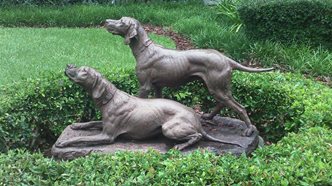
When Plant’s resort first opened in 1891, this French statue, “Au Coup de Fusil,” which means at the ready, was stationed at the opposite side of the Hotel, to greet guests as they arrived by train. Today, they are facing downtown and are there to welcome you as you walk up the stairs to the Henry B. Plant Museum. The dogs were designed by the French female artist Eglantine Lemaitre, daughter of the renowned French magician Jean-Eugène Robert-Houdin. Lemaitre enjoyed sculpting dogs and hunting scenes, and she sought to capture their natural features.
Cuando el complejo de Plant abrió por primera vez en 1891, esta estatua francesa, "Au Coup de Fusil", que significa "En ristre", estaba situada en el lado opuesto del hotel, para recibir a los huéspedes cuando llegaban por tren. Hoy en día, da al centro de la ciudad y están allí para darles la bienvenida mientras suben las escaleras del museo Henry B. Plant. Los perros fueron diseñados por la artista francesa Eglantine Lemaitre, hija del renombrado mago francés Jean-Eugène Robert-Houdin. A Lemaitre le fascinaba esculpir perros y escenas de caza, y buscaba capturar sus características naturales.
The DeSoto Oak El Roble DeSoto

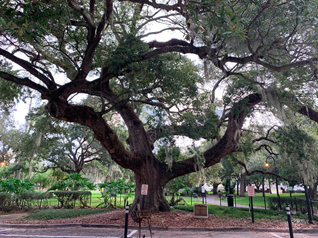
Early Tampa residents claimed that this majestic, live oak, The DeSoto Oak, was standing well before the hotel was built. Hernando DeSoto, a Spanish explorer, passed through this region in search of new territory for his country. Plant wanted his guests to be able to stroll or ride in a rickshaw to see and to be seen by other guests from the wide veranda. These oaks, now iconic symbols of southern gardens, were as exotic, as were the flowers that landscape designer Anton Fiehe brought here from the Caribbean and other foreign locales.
Los tempranos residentes de Tampa afirmaban que este majestuoso roble vivo, el roble DeSoto, estaba en pie mucho antes de que se construyera el hotel. Hernando de Soto, un explorador español, pasó por esta región en busca de nuevo territorio para su país. Plant quería que sus huéspedes pudieran pasear o montar en un bicitaxi para ver y ser vistos por otros huéspedes desde la amplia terraza. Estos robles, ahora símbolos icónicos de los jardines del sur, eran tan exóticos como las flores que el diseñador paisajista Anton Fiehe trajo aquí del Caribe y otros lugares del extranjero.
The Creek El Arroyo

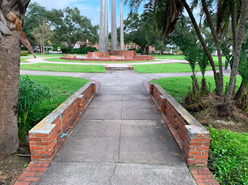
Do you see that small stream cutting through the grounds? It springs up under the front end of the edge of the hotel, and the original design included walls along both sides with small bridges for guests to either cross or simply sit and gaze at the garden. Today, it meanders throughout the park with fish, frogs, and lizards making the creek come alive. It also provides a safe, freshwater breeding nursery for the animals and birds of the park.
¿Ven ese arroyo pequeño que atraviesa el terreno? Surge bajo el extremo delantero del borde del hotel, y el diseño original incluía muros a lo largo de ambos lados con puentes pequeños para que los huéspedes los cruzaran o simplemente se sentaran y contemplaran el jardín. Hoy en día, serpentea por todo el parque con peces, ranas y lagartijas haciendo que el arroyo cobre vida. También proporciona una guardería segura de agua dulce para los animales y los aves del parque.
Sticks of Fire Palos De Fuego
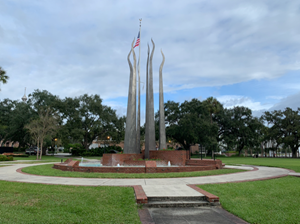
The modern sculpture in the center of the park is called Sticks of Fire by O.V. Shaffer, based on the Seminole translation of Tampa. It was a gift to The University of Tampa in 1984. From the early 1900s, Tampa’s society held picnics, teas, and parties around a rock garden fountain which had Japanese lanterns strung above it. Many of the rocks were Florida geoids, but visitors saw the sparkling rocks and called it The Jewel Box.
Esta moderna escultura en el centro del parque se llama "Palos de fuego" por O.V Shaffer, basada en una traducción del nombre seminole de Tampa. Fue un regalo a la Universidad de Tampa en 1984. Desde principios de 1900, la sociedad de Tampa organizaba picnics, tés y fiestas alrededor de una fuente de jardín de rocas que tenía linternas japonesas colgadas sobre ella. Muchas de las rocas eran geodas de Florida, pero los visitantes veían las rocas brillantes y la llamaban "El Joyero".
Palm Walk El Paseo del las palmeras

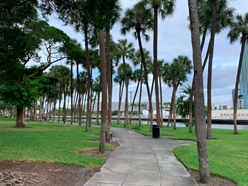
Strolling toward the river, you’ll see the proud symbol of the state of Florida: the Sabal palm. Please enjoy the breathtaking Palm Walk with the hand-picked, long-living palm trees planted by Anton Fiehe and the views of the Hillsborough River. Spanish bayonet plants were masked along the river to protect the grounds from intruders who might have wandered into the paradise. Plant featured roaming peacocks, raccoons, and monkeys through the park. Years later, the grounds had caged black bears and alligators. Today, some Tampa natives still remember seeing some of these animals here before they were moved up the Hillsborough River to a new home at the Zoo Tampa. Additionally, the benches you see placed along the path were designed as replicas of those found in Central Park.
Paseando hacia el río, verán el orgulloso símbolo del estado de Florida: la palma Sabal. Disfruten del impresionante Paseo de las palmeras con las palmeras de larga vida que plantó Anton Fiehe y de las vistas del río Hillsborough. Las plantas de bayoneta española se enmascaraban a lo largo del río para proteger los terrenos de intrusos que podrían haber vagado por el paraíso. El parque Plant presentaba pavos reales, mapaches, y monos, errantes por el parque. Años más tarde, los terrenos tenían osos negros y caimanes enjaulados. Hoy en día, algunos nativos de Tampa todavía recuerdan haber visto algunos de estos animales aquí antes de que fueran trasladados por el río Hillsborough a un nuevo hogar en el parque zoológico Zoo Tampa. Además, los bancos que se ven colocados a lo largo del camino fueron diseñados como réplicas de los que se encuentran en Central Park.
The Folly El Muro

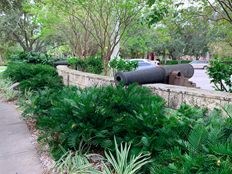
This is the garden Folly. Henry discovered the two, pre-Civil War cannons in the ruins of the old Fort Brooke. The cannons were placed near this spot and surrounded by plants to add history and mystery to the park. You can learn more history about the cannons on the plaque at the base of the limestone wall. Plant’s original wall was created from solid blocks of Florida’s bedrock. The wall you see today was recreated by using a veneer of limestone. If you look closely, you may be able to see the crushed shell in the compressed deposits. Please take a moment and relax on a nearby bench to absorb the history and the natural beauty that transcends over a hundred plus years.
Henry descubrió estos dos cañones del tiempo antes de la Guerra Civil al otro lado del río Hillsborough, en las ruinas del viejo Fuerte Brooke. Los cañones fueron colocados cerca de este lugar y rodeados de plantas para añadir historia y misterio al parque. Pueden aprender más historia sobre los cañones en la placa en la base del muro de piedra caliza. El muro original de Plant fue creado con bloques sólidos del lecho de roca de Florida. El muro que ven hoy fue recreado usando una chapa de piedra caliza. Si miran de cerca, podrán ver la cáscara aplastada en los depósitos comprimidos. Por favor, tómense un momento y relájense en un banco cercano para absorber la historia y la belleza natural que trasciende más de cien años.
Flagpole El astra de bandera

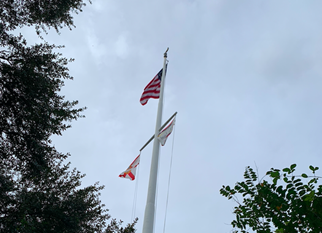
Look up! Henry constructed a flagpole almost as high as the minarets of the hotel and topped it with a similar crescent. Erected in 1894, this display of flags was the popular American trend at the time. Flagpoles were erected on school grounds, and Flag Day would soon become an American institution. With this flagpole marking Henry’s hotel, his steamships could navigate up the bay and into the river. On the cross arms, you now see the flags of the University of Tampa and the state of Florida, but originally, Henry displayed his own Plant System flag. The American flag you see flying is a replica of the 1896 forty-five-star flag. Utah was just officially added to the union, joining newer states, such as Wyoming, Idaho, Washington and Montana.
¡Miren hacia arriba! Henry construyó un asta de bandera casi tan alta como los minaretes del hotel, y la coronó con una media luna similar. Erigida en 1894, esta exhibición de banderas era una moda popular en esa época. Las astas de bandera se erigían en las escuelas, y el Día de la Bandera pronto se convertiría en una institución americana. Con el asta de bandera marcando el hotel de Henry, sus barcos de vapor podían navegar por la bahía y entrar al río. En las varas cruzadas, ahora se ven las banderas de la Universidad de Tampa y del estado de Florida, pero originalmente, Henry mostró su propia bandera de Plant System. La bandera americana que se ve ondear es una réplica de la bandera de 45 estrellas de 1896. Utah acaba de añadirse oficialmente a la unión, uniéndose a nuevos estados, tales como Wyoming, Idaho, Washington y Montana.
Star-Shaped Bed El macizo de flore en forma de Estrella
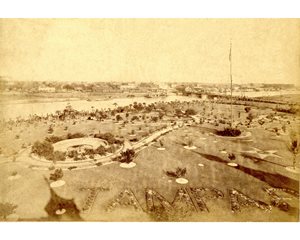
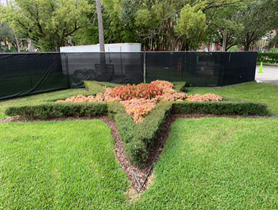
Early visitors enjoying their walk through the garden said, “We passed in this bed, the violets in bloom, equally large beds of blooming pansies, beds of fragrant roses, clusters of oleanders and bamboo, pineapple and, in fact, numbers of tropical flowers.” The star-shaped bed you are facing was recreated from one that Anton Fiehe designed to display annual flowering plants in the gardens. In Victorian gardens, these displays showcased exotic plants, which were collected worldwide. During the 1890s, this vegetation was first cultivated in the hotel’s three glass conservatories, originally located to the right of where the bed now rests. In the evening, visitors were delighted to stroll through the grounds illuminated with electric lights from Tampa’s first power plant, which was built on these very grounds in 1891.
Los visitantes tempranos que disfrutaban de su paseo por el jardín dijeron: "Pasamos por este macizo, por las violetas en flor, macizos igualmente grandes de pensamientos en flor, macizos de rosas fragantes, racimos de adelfas y bambú, piña y, de hecho, un gran número de flores tropicales". El macizo en forma de estrella al que se enfrenta se recreó de uno que Anton Fiehe diseñó para mostrar las plantas de floración anual en los jardines. En los jardines victorianos, estas exhibiciones mostraban las plantas exóticas, que se recogían por todo el mundo. Durante la década de 1890, esta vegetación fue cultivada por primera vez en los tres conservatorios de cristal del hotel, originalmente situados a la derecha de donde ahora descansa el macizo. Por la noche, los visitantes estaban encantados de pasear por los terrenos iluminados con luces eléctricas de la primera planta de energía de Tampa, que fue construida en estos mismos terrenos en 1891.
"Transportation" Statue and Fountain La Estatua "Transporte" y la Fuente
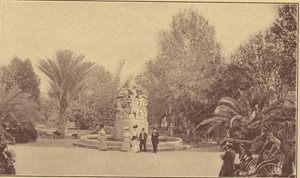
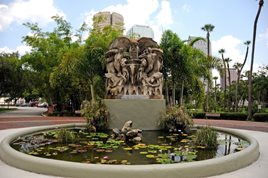
This fountain is a focal point from the veranda and showcases the statue, “Transportation,” which was thought to be commissioned by Margaret Plant in 1899 in memory of her late husband, Henry. This statue by George Grey Barnard is one of the earliest pieces of public art in Tampa. Note the ship and train, representing the foundation of Henry’s transportation empire. The eagle holding the strongbox was the logo of Henry’s first company, The Southern Express Company.
Esta fuente es un punto focal de la veranda y muestra la estatua, "Transporte", que se creía que fue encargada por Margaret Plant en 1899 en memoria de su marido difunto, Henry. Esta estatua de George Grey Barnard es una de las primeras piezas de arte público en Tampa. Fíjense en el barco y el tren, que representan la fundación del imperio del transporte de Henry. El águila que sostiene la caja fuerte era el logo de la primera compañía de Henry, The Southern Express Company.
More about Henry B. Plant Más sobre Plant
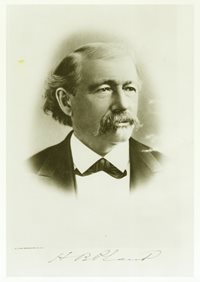
Henry Plant was born in Connecticut, and traveled to Florida in 1853 when his wife was dispatched to a warmer climate for medical reasons. The Plants first arrived in Jacksonville, and it didn’t take long for thirty-four-year-old Henry, always the entrepreneur, to see the possibilities. After the Civil War, the railroads in the south were devastated. Many declared bankruptcy, yet Henry saw opportunity. He began acquiring smaller railroads and continued building a complete transportation network that grew into an empire. By 1898, the Plant system owned fourteen railway companies and several steamship lines. Henry’s portfolio also boasted lavish hotels, including the Hotel Belleview in Clearwater. Of his eight luxury accommodations, the Tampa Bay Hotel, facing the Hillsborough River and Plant Park, stood alone in terms of elegance and grandeur. It was known by its fanciful Moorish Revival architectural style and today by its famous silhouette, a distinctive part of Tampa’s skyline. Henry opened this hotel in 1891, spending three million dollars of his personal fortune. At the time, Tampa had only several hundred residents, but Henry was convinced his hotel would thrive as Florida’s wealth and population grew. The building, a designated National Historic Landmark, is now a part of The University of Tampa and home to the Henry B. Plant Museum. The building and park share a unique and rich history. So many stories, so many treasured memories.
Henry Plant nació en Connecticut, y viajó a Florida en 1853 cuando su esposa fue enviada a un clima más cálido por razones médicas. Los Plant llegaron primero a Jacksonville, y Henry, a los 34 años, siempre el empresario, no tardó mucho en ver las posibilidades. Después de la Guerra Civil, los ferrocarriles del sur fueron devastados. Muchos se declararon en bancarrota, pero Henry vio la oportunidad. Empezó a adquirir ferrocarriles más pequeños y continuó a construir una red completa de transporte que se convirtió en un imperio. En 1898, el sistema Plant era propietario de catorce compañías ferroviarias y de varias líneas de barcos de vapor. La cartera de Henry también contaba con hoteles lujosos, incluyendo el hotel Belleview en Clearwater. De sus ocho alojamientos de lujo, el Tampa Bay Hotel, frente al río Hillsborough y Plant Park, era el único en términos de elegancia y grandeza. Se conocía por su extravagante estilo arquitectónico del renacimiento moro y hoy en día por su famosa silueta, una parte distintiva del horizonte de Tampa. Henry abrió el hotel en 1891, gastando tres millones de dólares de su fortuna personal. En ese momento, Tampa sólo tenía unos cientos residentes, pero Henry estaba convencido de que su hotel prosperaría a medida que la riqueza y la población de Florida crecieran. El edificio, designado como monumento histórico nacional, es ahora parte de la Universidad de Tampa y el hogar del museo Henry B. Plant. El edificio y el parque comparten una historia única y rica. Tantas historias, tantos recuerdos atesorados.
The Tampa Bay Hotel El Hotel Tampa Bay
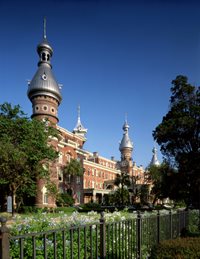
As the Tampa Bay Hotel’s popularity waned with the economy of the 1930s, the gardens began to lose their beauty, and the Hotel was closed in 1932. Then, in 1933, the City of Tampa (who had purchased the Hotel and grounds in 1905) leased them to a young junior college. The University of Tampa was on its way. Now, the University extends far beyond the original grounds of the Hotel. Many new buildings replaced those lost to fire and disrepair. The University, the City, and the Museum all work together to protect and recreate Plant Park, this historic garden. Look around and you’ll see the students reading under the trees planted by Anton Fiehe, playing ball where Plant’s shell walkway led visitors to his Casino and boathouse, or lounging on the benches, which are replicas of the benches from the 1890s and those found in Central Park. This historic park provides a beautiful respite on the edge of a dynamic urban setting.
A medida que la popularidad del hotel Tampa Bay disminuyó con la economía de los años 30, los jardines comenzaron a perder su belleza, y el hotel se cerró en 1932. Luego, en 1933, la ciudad de Tampa (que había comprado el hotel y los terrenos en 1905) los arrendó a un colegio universitario nuevo. La Universidad de Tampa estaba en camino. Ahora, la universidad se extiende mucho más allá de los terrenos originales del hotel. Muchos edificios nuevos reemplazaron los que fueron perdidos por el fuego y el deterioro. La universidad, la ciudad y el museo trabajan juntos para proteger y recrear el parque Plant, este jardín histórico. Miren a su alrededor y verán a los estudiantes leyendo bajo los árboles plantados por Anton Fiehe, jugando a la pelota donde el paseo de conchas de Plant llevaba a los visitantes a su casino y cobertizo de lanchas, o descansando en los bancos, que son réplicas de los bancos de la década de 1890. Este parque histórico proporciona un hermoso respiro en el borde de un dinámico entorno urbano.
To take the tour using your phone, visit Henry B. Plant Park and call 813.319.8445.
We would like to thank the students and their faculty mentors for the development of the Henry B. Plant Park phone tour project as part of UT’s Applied Learning Experience (ALEX) program.
Nos gustaría agradecerles a los estudiantes y a sus mentores de la facultad por el desarrollo del proyecto del recorrido telefónico del parque Henry B. Plant como parte del programa Experiencia de Aprendizaje Aplicado (ALEX) de la Universidad de Tampa.